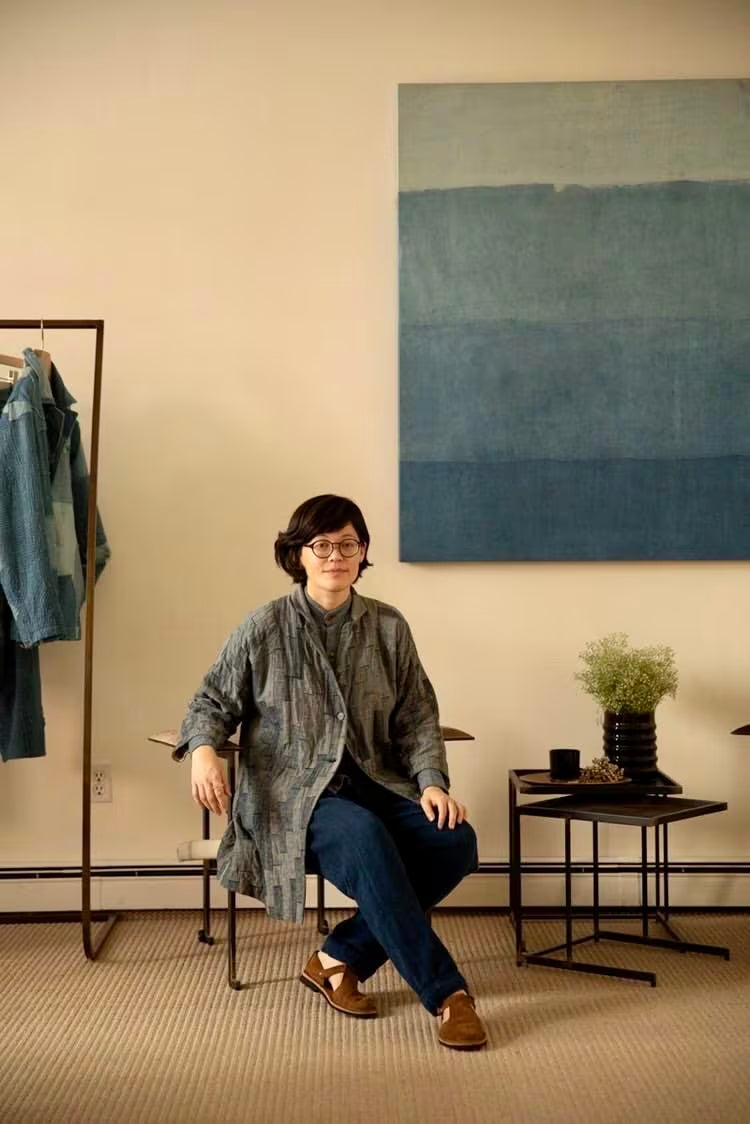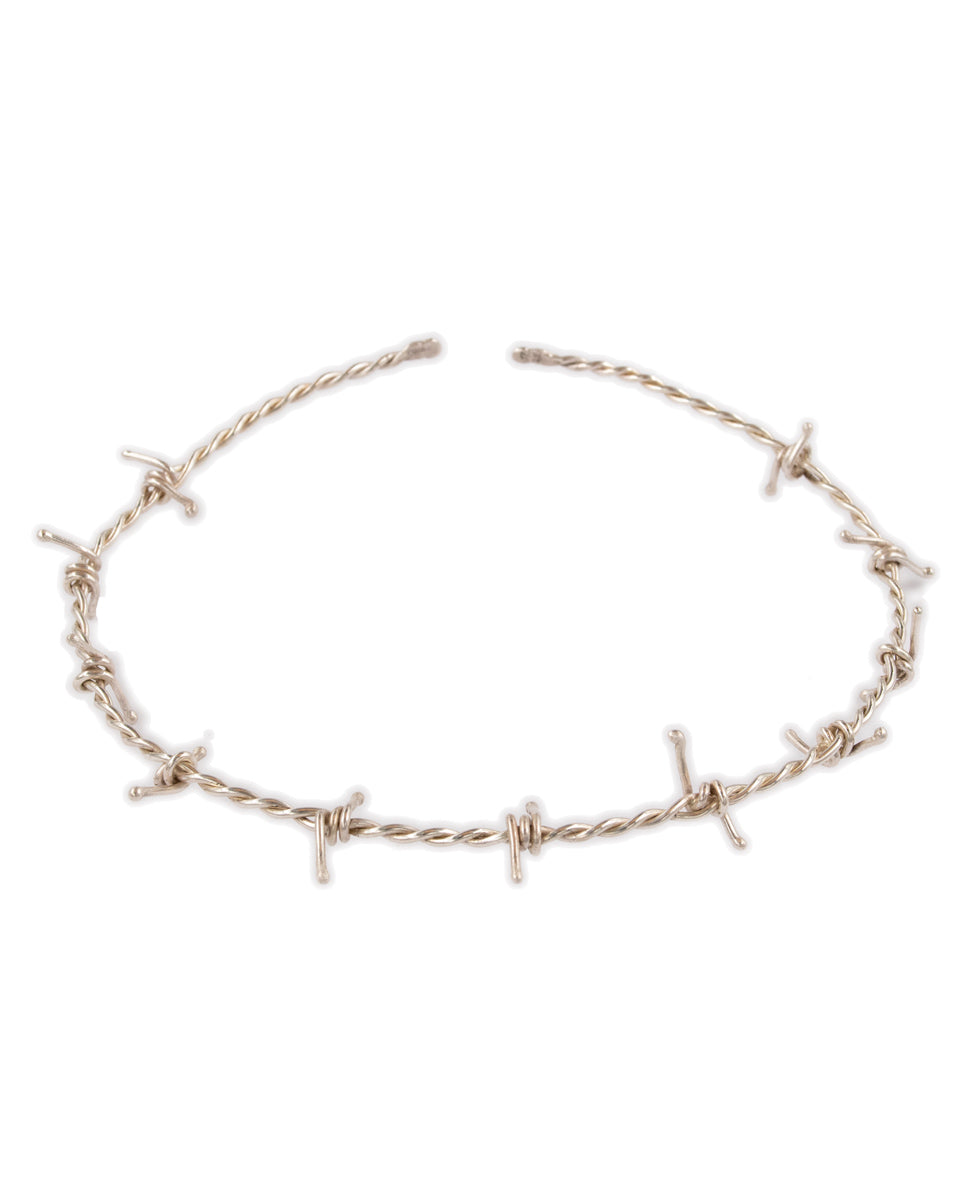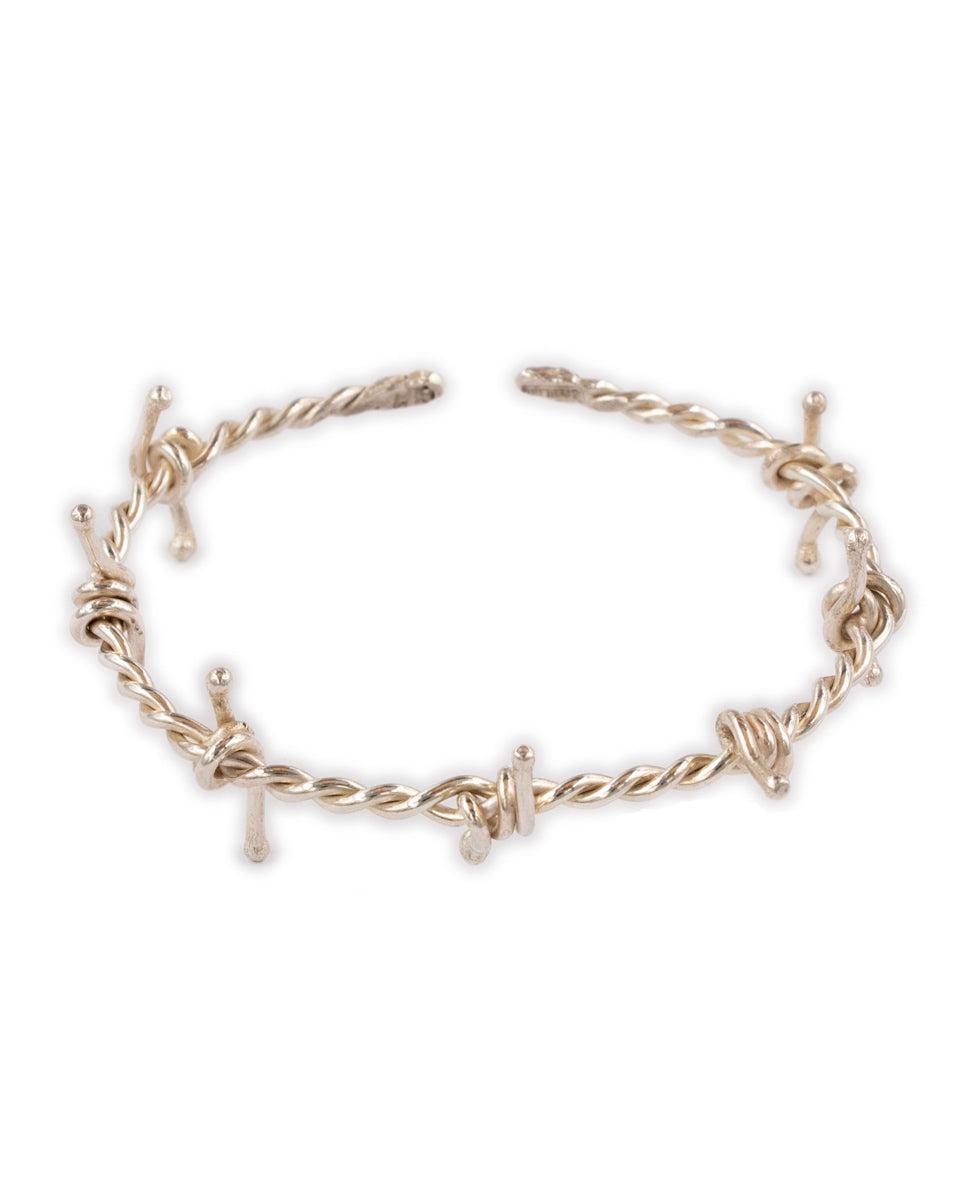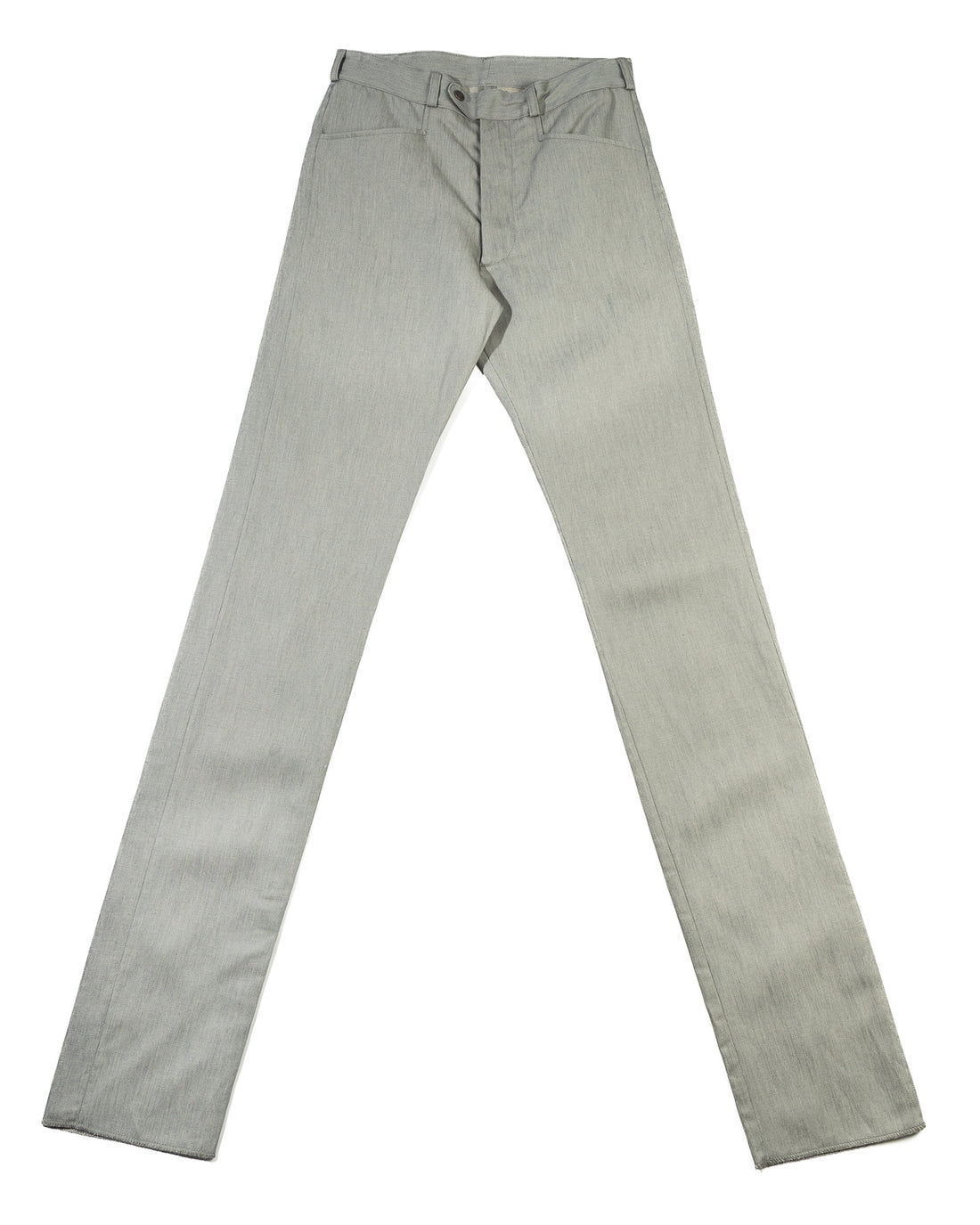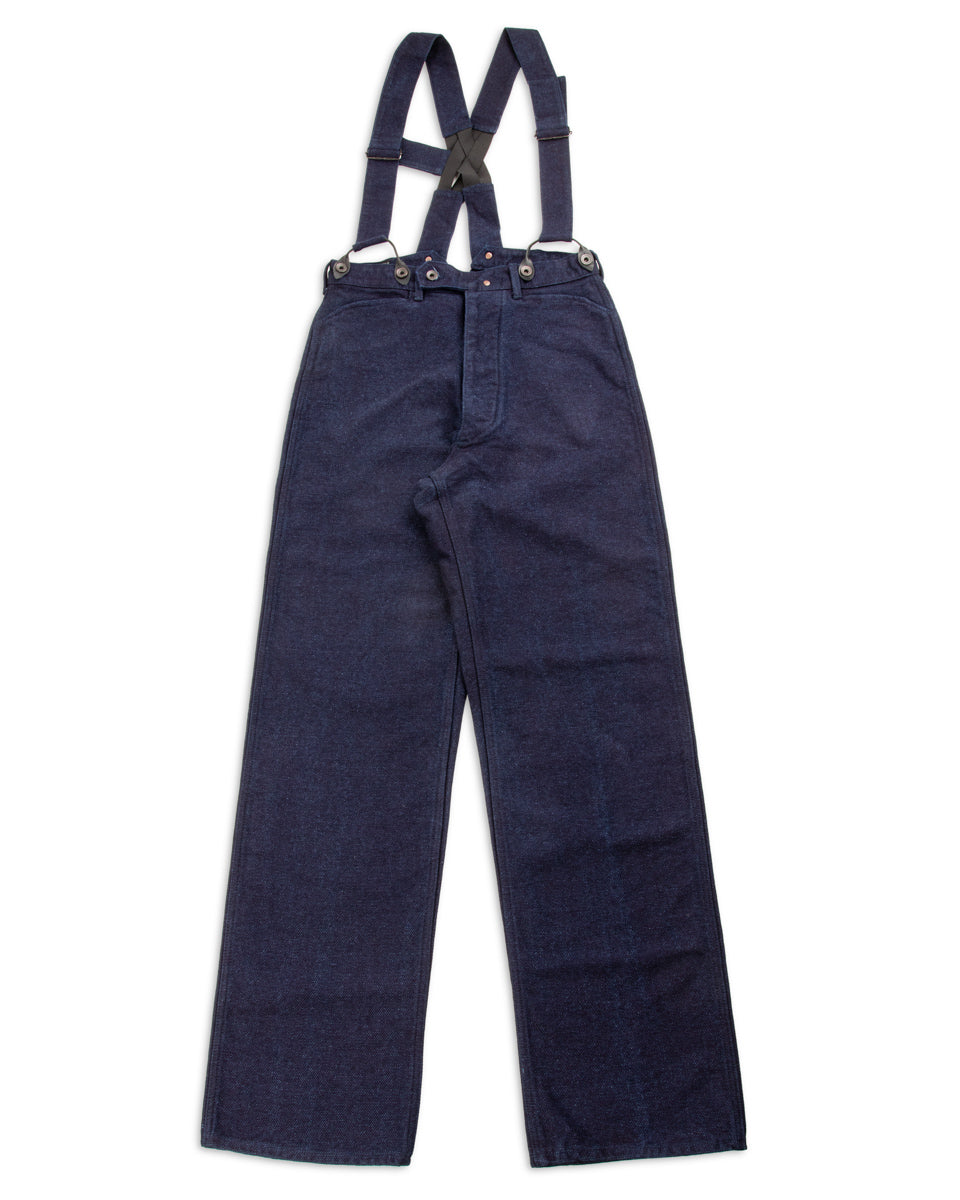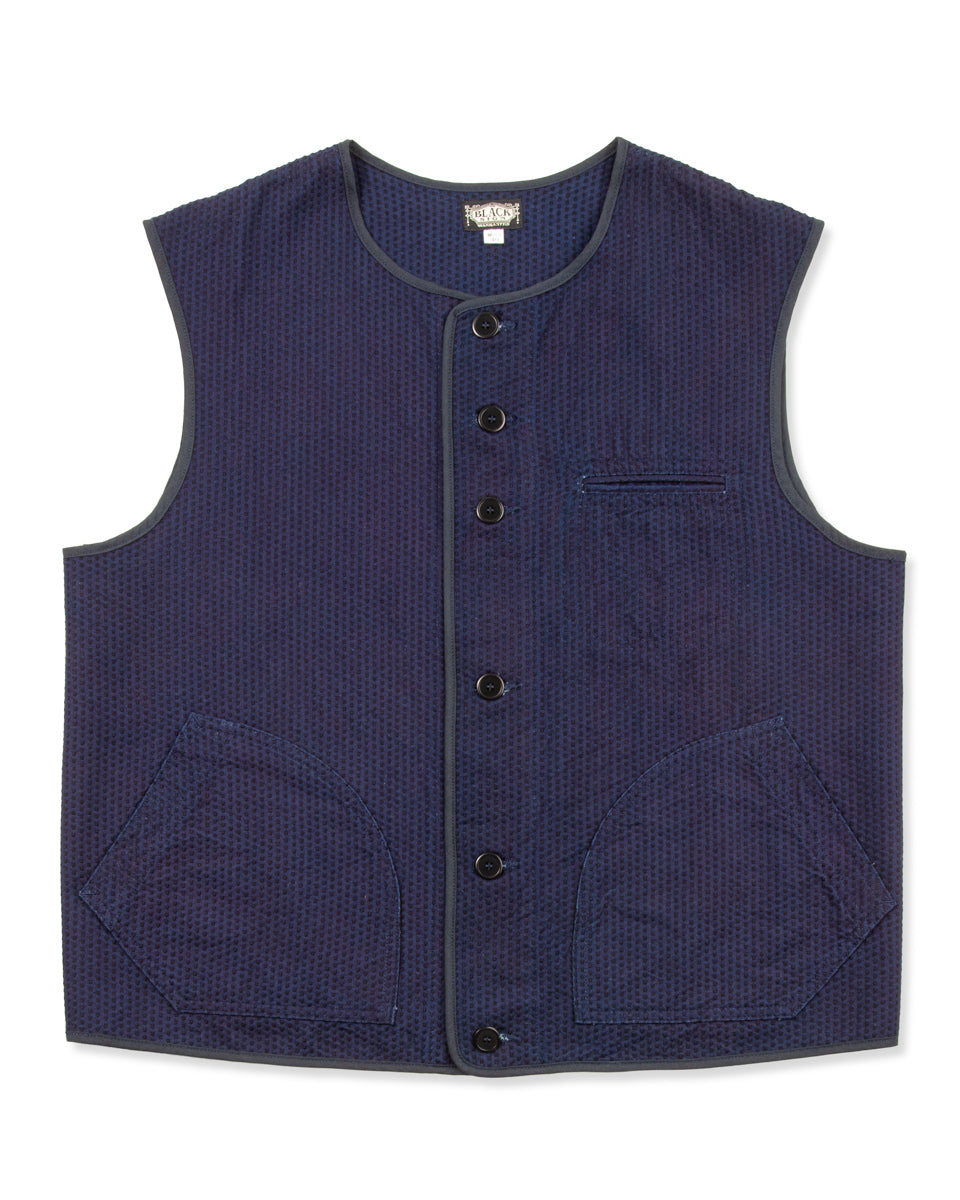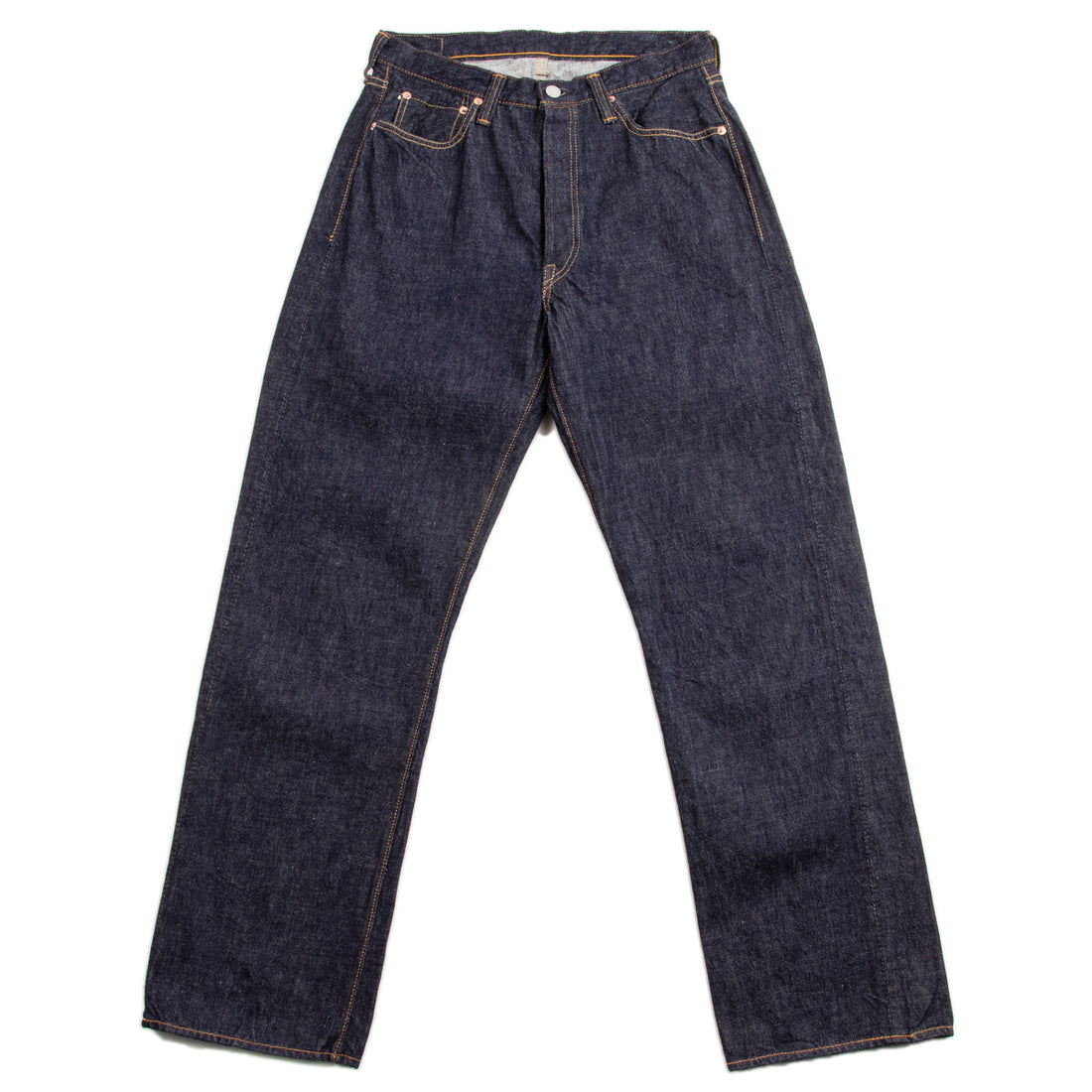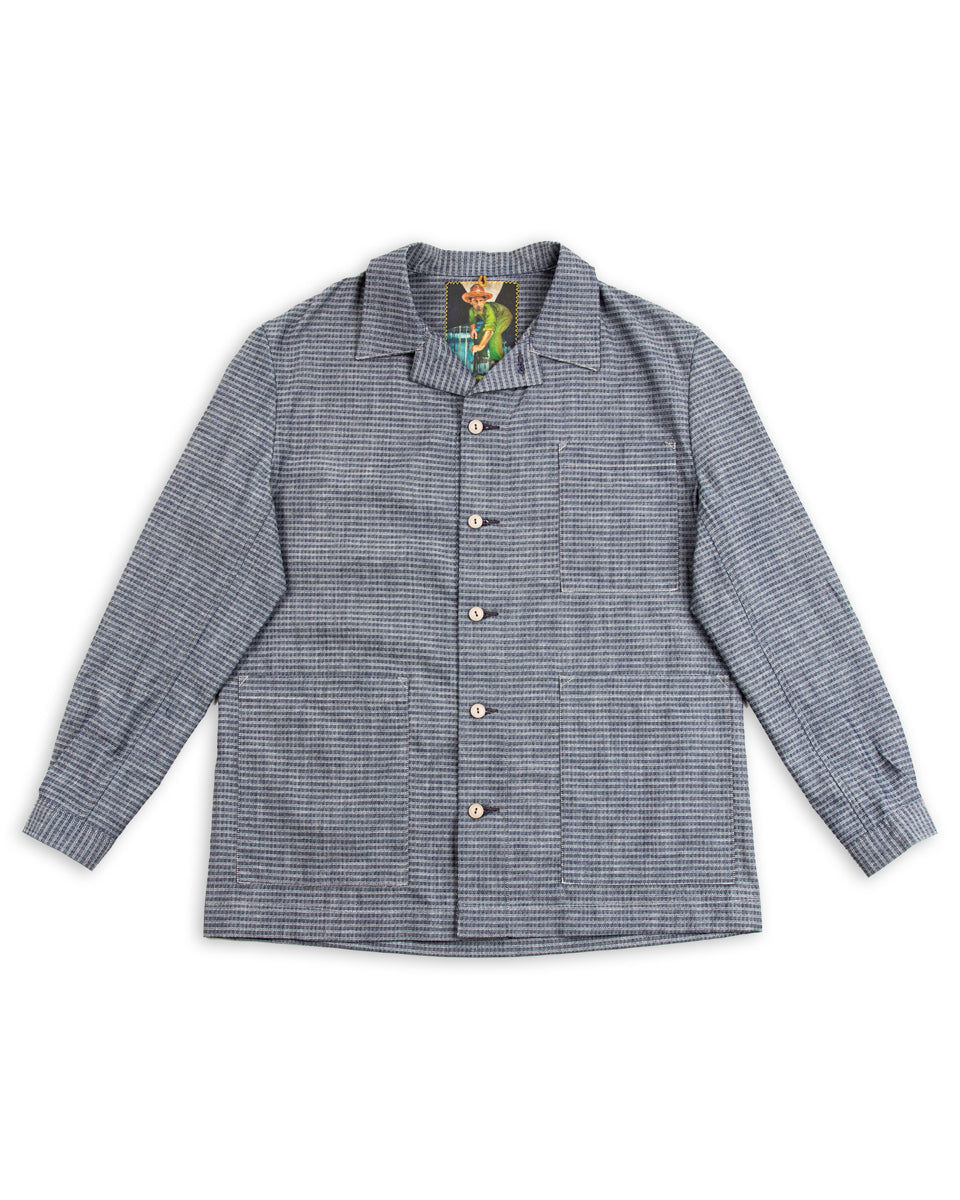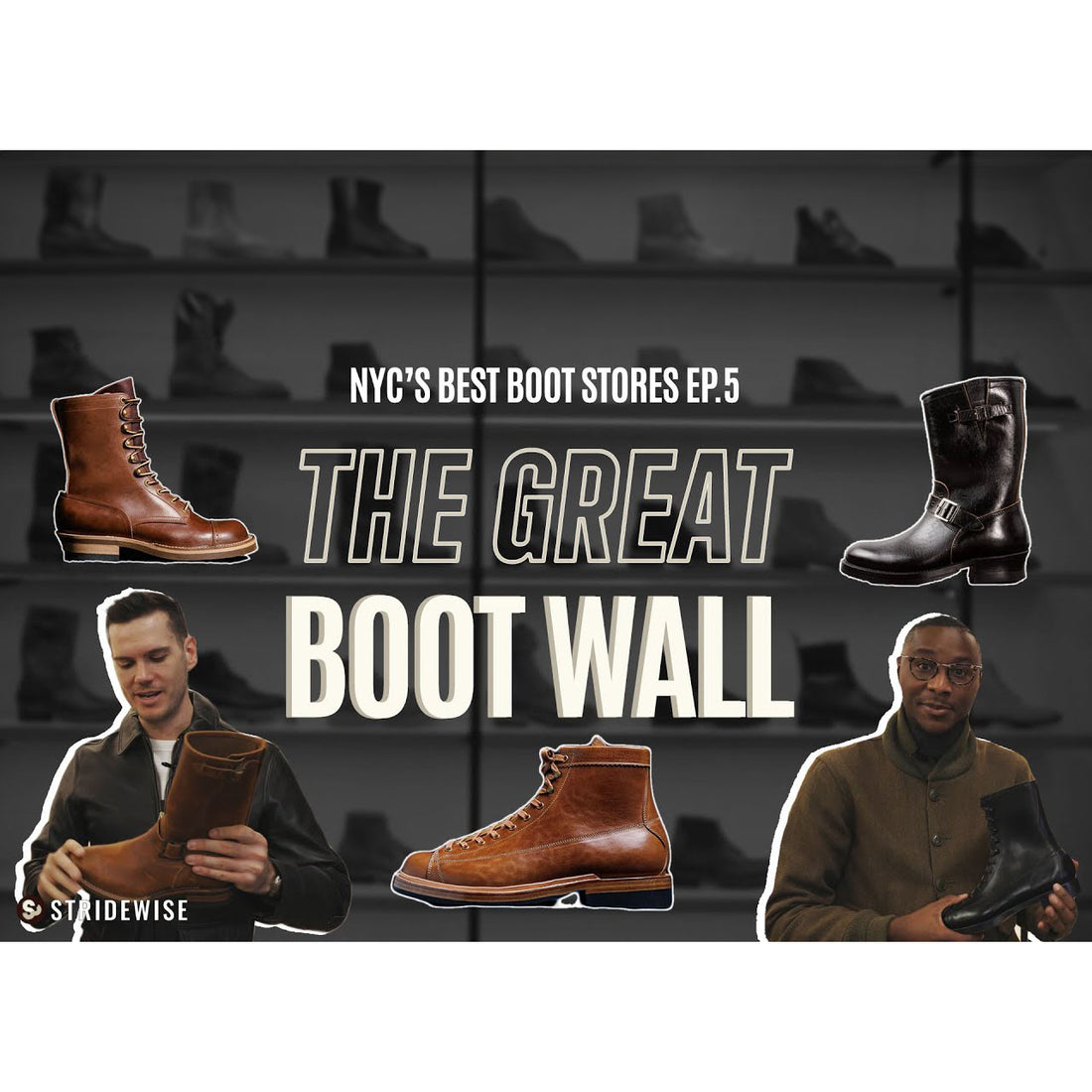
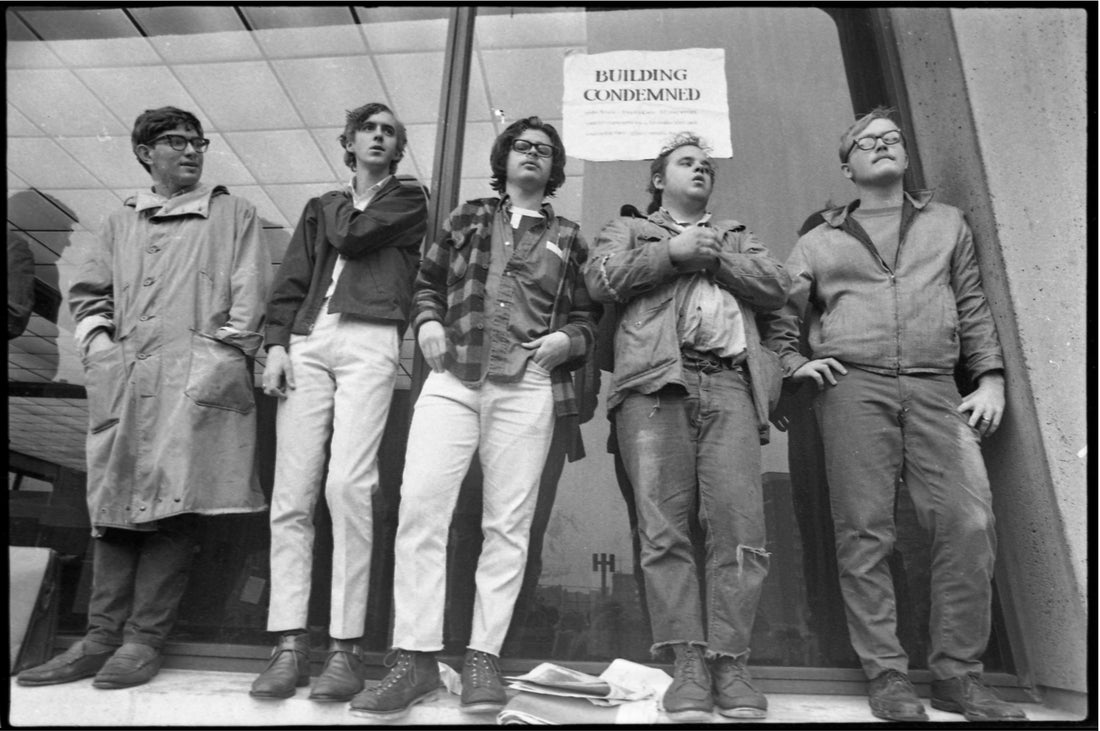
The Long Intertwined History of Indigo and Olive Drab
The connection between Military surplus and denim has been there since the beginning. With canvas sneakers, T-shirts, and sweatshirts, jeans and military surplus are the blank canvases of American style. Adopted by countless subcultures, from bikers and hot rodders to hippies and punks. Their uniformity and utilitarianism are the perfect vessels for any group’s identity. Their lack of intrinsic fashion allows them to become anyone’s fashion.
Detail of a photo of a gas station attendant in the late 1940s. He wears an Army HBT top and hat and denim carpenter jeans. The Portland Public Library.
Surplus uniforms, similar to denim, have their roots in American workwear. In the postwar period, industrial and rural workers wore military clothing as workwear. Available in stupendous quantities, well-made for rugged wear, and cheaper than commercially made workwear, the military surplus was an obvious choice for workers. Right after the war, the Dean Brothers opened up “Dean Government Surplus.” The brothers were able to buy khaki trousers from the government for $2, a quarter of what new trousers retailed for in 1946. "People would come in and buy a dozen pairs of pants at a time," said one of the brothers in a Smithsonian Magazine piece on war surplus. The son of an Army Navy Store owner in Orange County, California reflected decades later, “the store had camping gear, canvas, clothing, work shoes and much much more… Men from all over would come at regular intervals to buy their “gear.”” This trend is demonstrated by a striking dairy farmer captured by a Life Magazine photographer wearing an M-1943 field jacket with his overalls and wool work cap and another image of an auto-worker walking past the open casket of Henry Ford, “still in factory clothes,” also wears an M-1943 field jacket. This mix of workwear and uniforms was further canonized in the 1954 film On the Waterfront. A Newsweek article from 1965 called surplus stores “that old friend of the workingmen, stevedores, and sportsmen.” While not as poetic as “beating swords into plowshares,” the uniforms of WWII played an integral role in outfitting the workers.
Striking Dairy Farmers in Michigan, late 1940s/1950s (courtesy of the Life Photo Archive powered by Google); “Two Ford workmen, still in factory clothes, stand in silent awe before the coffin of the man who made Detroit a synonym for production” Life Magazine April 21, 1947
Surplus stores quickly began to stock more traditional workwear among the military gear. Jeans and other work pants, along with work boots, became part of the Army Navy Store inventory. Writing of the importance of military surplus in American Men’s style in his essay “Up from the Bottom: Roots of American Style,” G. Bruce Boyer recounts:
“We all bought our jeans there [the Army Navy Store], either Levis, Wrangler, or Lee, the only three brands sold in the 1950s. And the accompanying denim ranch jackets, unlined in summer, flannel lined for winter. Some guys would cut the sleeves off and wear the jackets as vests. Before the age of manufactured-distressing, we soaked our denim in buckets of water to get some of the indigo dye – which stained the hands -- and stiffness out. I still have the smell of new jeans in my memory.”
By the 1960s, nearly any reference to surplus stores in the media mentioned jeans or dungarees. In 1965 the Chicago Tribune wrote, “it may not be fashion but its a current passion among the teen-agers to borrow from the boys in blue [sailors].” The New York Times noted a similar trend of college students heading to the surplus store. At the Army-Navy Surplus store on 42nd St. “socialites and college girls” crowded out the male surplus store customer in their fashionable search. The “fashion customers” had started shopping at the surplus store a few years prior, according to the owner, when “girls took to men’s dungarees.” The salesmen of the surplus store worked to translate men’s military sizing to women’s. The article features two college students, one looking for a peacoat and the other for an Army shirt. Today, while surplus stores are more scarce, they will still stock jeans and work boots. Students were attracted to surplus and denim for various reasons.
"Discarded Army, Navy, and Marine Corps uniforms will play an important role in campus fashions this winter" December 3, 1945. Elmira College, New York. Author's collection.
Throughout the 1950s and 60s, the collegiate style had become increasingly casual. Women students' fashions of the 1950s would be described as “sloppy” and often included dungarees or Military Surplus. This photo from Elmira College in 1945 shows a group of students all wearing “Discarded Army, Navy, and Marine Corps uniforms” as well as two of them in cuffed dungarees.
A few years later, in the late 1960s, with counter-culture movements and anti-war movements sweeping the country, denim and surplus styles blossomed among college students. Denim and surplus took on a political tint. Blue jeans and olive drab became the colors of non-conformity and resistance against the dominant American culture of conformity, consumerism, and support for the war in Vietnam. As one Army Navy store manager in Boston said in 1970, “the kids tell me they’re boycotting fashion and rebelling against the system. I believe them.”
Two photographs from college yearsbooks in the late 1960s early 1970s.
Along with the Army-Navy store surplus, denim would become the defining style of the late 1960s. The expansion of jeans surplus into collegiate fashions was part of the general trend toward more rugged and casual clothing for students. But, unique to the late 1960s, jeans and surplus also figured prominently in social and political movements of the era. They were more than just rugged, hard-wearing, and cheap clothes for students. “If jeans or army surplus were just sturdy and cheap, would they enjoy the prestige they do? Beyond their obvious material advantages, their uniformity speaks to a generation that finds its identity en masse (the Peasant, the worker, the soldier, the primitive horde – whatever mass preys upon urban civilization, suffers at its hand or renounces it, whatever mass lives outside it.),” wrote a professor at Stony Brook University in 1972. While not in uniform, military surplus and denim as a uniform by young people signaled their opposition to the status quo, or as the professor wrote, “outside of it [society].” The use of uniforms as a tool against uniformity is, of course, ironic, but more importantly, it is attempting to remove clothing from fashion and by extension, American consumer culture.
The garments in question, blue jeans and olive green fatigues, and field jackets were not designed as fashion but as utilitarian garments which may make up the raw material needed for an individual style. Made outside the fashion system, they can be used for true self-expression and not what is fashionable. Interviewed by the Boston Globe, one female student said in 1970 fashion “is the epitome of competition. It is the basis of a materialistic society.” Further along in the piece, a Radcliffe student comments, “the great counter-culture movement has instigated a breakdown in traditional dress. There has been a great change in values. Fashion designers have lost their control.” The author continues, “The young who are boycotting fashion are examining the whole concept of American advertising and the Madison Avenue myth, which chips away at the subconscious by hammering home the idea that trappings, like fashion, are a mark of excellence.” At the heart of the denim and surplus style was rejecting the dominant American culture.
A woman wearing a M-1951 field jacket with jeans. The East Village Other, May 11, 1971.
Jeans had been strongly associated with the fiercely independent rebels and those on the edge of society for decades through movies like Rebel Without a Cause and The Wild One. In the 1960s and 70s, army surplus began to be as well, first, like jeans, through genuine popularity and then through cultural products. Movies like Serpico and Taxi Driver made military surplus instantly recognizable as symbols of disaffection, opposition to the status quo, and general outsider status.
It is a mistake to think that there was no style to the uniform. While the mix of surplus and denim may have been made of uniforms, it did not make for uniformity. The skeptical Stony Brook professor aptly wrote, “nestling in these among the sameness you always find are these little personal touches, always just a little something to adapt the uniform to a private sense of style.” by opting out of dominant fashions and trends, students believed that the true self could come out. What the professor calls “private” style could easily be interpreted as “personal style.” Jeans and military surplus were the raw material used to create a personal style, blank canvases (sometimes literally) that young people could use to express themselves and form identities.
Al Pacino as Serpico in the 1973 film. He wears an M-1965 field jacket and denim dungarees
While jeans were an important part of the Army surplus look, it was not unique to it. Jeans had started to be more widely accepted in the American wardrobe before Army surplus was, so of course, a wider population of young Americans dressed in jeans. In a book about the University of Wisconsin, Madison, by the folklorist Robert Gard, he describes the universality of denim in the collegiate wardrobe, “From army surplus modern and Edwardian Effete to Langdon Street Clean Cut and Dirty Hippie Dilapidated. The Common denominator is there, in the ubiquitous jean, but from there onward, the great divergence begins.” As early as 1968, jeans were becoming recognized as a key part of young people’s wardrobes regardless of the rest of their look. The New York Times reported in 1968 on the styles of the Ivy League students, ending their report with “But everywhere in the Ivy League as on five continents, the lingua franca of young male fashion is pronounced blue jeans.” While surplus military attire was still a definite look or style, jeans were becoming the foundational garment across innumerable fashions.
Beginning in the early 1970s, pre-washed and distressed jeans came onto the scene to compliment the more tattered surplus looks worn by students. Industry professionals began to notice that young people, looking to get a more worn-in look fast, would dip their jeans in bleach, purposely rip them, or even sew on fake patches where there were no holes. “Many young people have come to prize the fade and the frays more than the durability,” reported The Wall Street Journal. “It’s a badge of the “in” culture among young people to wear clothes that look almost worn out.” Blue Bell, the company that owns Wrangler, noticed this trend and invested in techniques that would bleach and tatter the jeans before they left the factory – some of the first pre-washed and distressed jeans – for an additional $2. “It saves the kids the trouble,” E A Morris, chairman of Blue Bell said at the time.
Model and actress Lauren Hutton wearing a quilted field jacket liner with jeans, 1977
But, as with most things, there would be a pendulum swing, a rejection of denim. By the mid-1970s, the youth of the late 1960s were fully grown and still wearing jeans. Jeans became the establishment, a look that the new youth of the era looked to reject. Of course, nothing could truly stop the indigo dominance, but in 1974 the Washington Post reported that “jeans may very well have met their match in khaki and olive drab fatigues and mechanics overalls.” For women’s looks especially, the 1970s ushered in a loose-fitting, baggy “Annie Hall” look that lent itself well to the fatigue look over traditional jeans.
Lagging only a few years behind, eventually, surplus military uniforms entered the popular American fashion lexicon. Like jeans, it became shorthand for casual looks and riffed and ripped off by countless designers. Now, there are only a few styles of clothing that nearly every fashion brand has in common. At the top of the list is a pair of jeans and a military jacket or fatigue of some kind. Jeans and military uniforms are pillars of the quintessential American style. Part of their shared history is their shared ability to be chameleons of American fashion, adopted by many generations and belonging to no one subculture.
Top photo: "MIT war research demonstration: demonstrators standing by a window outside a building, November 4, 1969." By Peter Simon. University of Massachusetts Amherst.
About The Author
Charles McFarlane is a MA student in Costume Studies at New York University. His research focuses on the intersection of 20th and 21st Century military uniforms and popular fashion and the semiotics of military uniforms. His writing has appeared in Monocle, and GQ among other publications. You can follow his work at his newsletter Combat Threads and on Instagram.
All the latest
Featured blog posts

